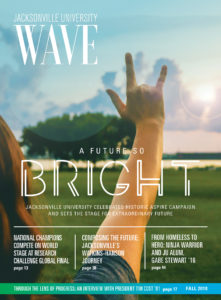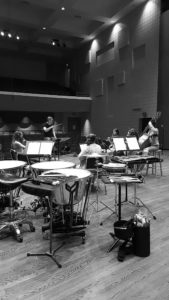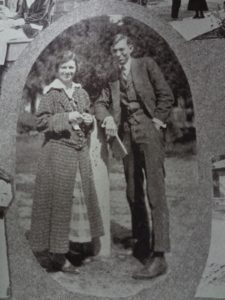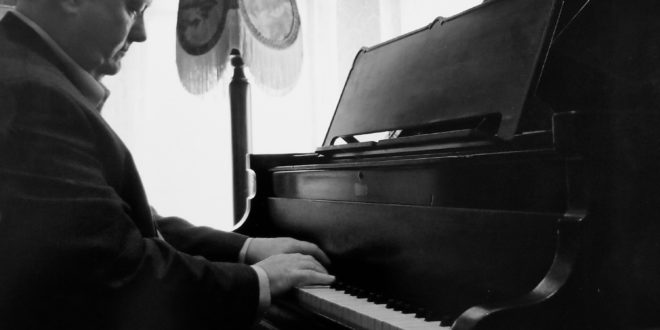
Dr. Scott Watkins, Professor of Piano and coordinator of keyboard studies at Jacksonville University (JU) since 2001, researches the early life of famed American composer Howard Hanson in his spare time, focusing on the years that preceded Hanson’s directorship at the Eastman School of Music (Eastman) in Rochester, New York. Watkins hopes this fresh and comprehensive look at the young, newly-motivated, and prolific musician, before he became a Pulitzer Prize winner, will inspire many.
He spent a portion of his summer in Wahoo, Nebraska, childhood home of Hanson, a research journey which began with what Watkins calls an “Indiana Jones moment.”
In December of last year, Watkins shared with WAVE Magazine exactly how he unearthed the never-before published Symphonic Rhapsody, Op. 14, for Solo Piano which premiered in October 1919.
“During my research, I learned that a famous Australian pianist and composer, Percy Grainger, had given a concert at the College of the Pacific where Hanson was teaching in 1920, and I had hopes of finding something from that concert. When I discovered a large, folded cardboard poster advertising the concert, I was thrilled and wondered why it was folded and tied with string. The Eastman archivist with me, David Peter Coppen, untied the string and nine pages of an unpublished manuscript—thought to have been lost—literally fell onto the table.”
Since that unforgettable moment, Watkins has performed the work a dozen times, for varied audiences, including March 19, 2017, in JU’s Terry Concert Hall; May 23, 2017, at the San Jose Woman’s Club; and twice on May 4, 2018, in Wahoo. Those concerts were held in downtown Wahoo and in the birthplace of Howard Hanson on the composer’s own piano in Saunders County.
Area newspapers in Saunders reported that, though the majority of Wahoo residents did not realize how well-respected and admired the composer continues to be nearly 40 years after his death, there is now a growing awareness. Watkins will perform the piece at the University of Nebraska this fall, plans for a Howard Hanson music festival in Nebraska are underway, a 100th anniversary New York premiere has been slated for October 2019, and the once-lost composition has since been published by Carl Fischer Music. Watkins’ name appears on the sheet music as editor.
“Nobody really comprehends what he did before Eastman. I’m trying to establish the formation of Howard Hanson.”
The remaining challenge is how to capture a true portrait of the 19-year old professor/composer/pianist/theorist who would later create seven orchestral works, including his Pulitzer Prize-winning Symphony No. 4 Op. 34, Requiem, as well as numerous choral, band, chamber, and solo piano pieces, and even an opera. Merry Mount (1934), widely considered the first thoroughly American opera, was set in, composed by, based on a story by, and performed by Americans.
“Nobody really comprehends what he did before Eastman. While at Eastman, every time Hanson stepped out for lunch, it was documented. Where he went, what time he left, with whom he went, what time he returned—all recorded. But before that, very little is known. I’m trying to establish the formation of Howard Hanson,” said Dr. Scott Watkins
The Numbers Behind the Major
A discovery like the lost Hanson composition begs the question: are universities producing musicians like Hanson today? According to the last U.S. Bureau of Labor Statistics count, nearly 75,000 people across the nation are employed as composers and/or music directors. Florida is among a handful of states with higher concentrations of such jobs.
Inside the industry, there are standouts, those listed as the hottest young composers in the U.S. right now—Missy Mazzoli, Nico Muhly, Mason Bates, Judd Greenstein, Gabriel Kahane. The question in higher education circles then becomes: will students continue to pursue degrees in this niche within the music world? Are universities doing enough to inspire and engage another generation of great composers?
“It’s virtually unheard of for a university of our size to have a vibrant fine arts and composition program,” Watkins says. “Student-centric concerts are one of the diamonds in our crown. Each year a student receives the Delius Award and is commissioned to compose something that will be rehearsed and performed by our symphony orchestra.”

Recent JU alumnus and winner of the prestigious Delius Award, Daniel Farrell ‘18, was a critical part of the Hanson discovery and publication process. Watkins says, “Daniel and I went over it a few times and he made a digital version ready for print.” Meanwhile, Watkins approached the Eastman School of Music in Rochester, seeking permission to submit for publication.
Farrell earned his Bachelor of Music degree in Composition and Theory, studying under Professor of Composition and Music Theory Dr. Jian Jun He and George ‘Tony’ Steve. He graduated summa cum laude with departmental honors and earned the Fred Noble Award in Scholarship. Farrell’s work was most recently featured in the Jacksonville Short Film Festival and his first international debut occurred during a 10-day Valencia International Performance Academy and Festival (VIPA) this past July in Spain.
“Hanson’s romantic and conservative approach speaks to me. It’s a huge shame that his solo piano works are not performed as much as they should be. His impact on pedagogy is unmatched,” Farrell says, he is excited to see a resurgence of interest in the American composer’s work due to the scholarship of Watkins.
This fall, he begins a Master of Music Composition and Theory in Film and Media Scoring program with the New York University Steinhardt Program, where he will further explore genre crossing. “No longer is jazz restricted to jazz, rock restricted to rock, classical to classical, etc. Contemporary composition combines all these aspects, creating new and completely unique soundscapes.”
Versatility is Key
Composition majors at JU complete coursework that includes multiple classes in music theory and performance, as well as training in choral literature, arranging, philosophy, conducting, counterpoint, transposition, film scoring, fugal technique, world music, and electronic music, to name only a few.
Watkins says, “When I was a kid, everybody wanted to be Van Cliburn. That was in the ’60s and ’70s.” Cliburn, who achieved worldwide recognition as a solo pianist by age 23, Watkins says is a prime example. But the economics surrounding the music industry soon shifted, and Watkins says it was no longer enough to have tremendous talent in one area.
“Today, you must be versatile, able to play in a wide variety of styles, and in multiple settings. You have to be able to sight read because time is money, and if you really want to be a commercial success, you must be versatile.”
Dr. He says the same, acknowledging that more and more people, as professional musicians or amateurs, are stepping into composition within the film industry. “This will be a much bigger market in future, and many young composers will start their careers in film.”
Watkins and Farrell agree that these versatile players stepping into a changed global market are, in essence, present-day Howard Hansons.
“When Hanson was the director of the Eastman School of Music from 1924 to 1964—the longest tenure the school has ever seen—Eastman and Juilliard had this ongoing feud. Juilliard attracted students seeking solo careers,” Watkins says. “But Eastman produced true musicians. Hanson’s theory was this: if you trained a student to be well-rounded, they would have far more successful careers.” According to both Hanson and Watkins, greater versatility meant greater employability.
Farrell agrees and says one of the best qualities of JU is the ability to personalize an educational experience and explore particular interests. “For me, that was music for film.”
Incorporating his many talents into a variety of film and media projects, he provided musical scores for “Dante: The Pilgrim,” an animated short film; “Luminous,” a video game beta developed by several JU art majors; “War and Peace,” another short film; and “Grilled,” the short recently featured in the Jacksonville Short Film Festival.
He is also scoring “The Dance,” an upcoming short by JU film major Michael Csorba.
“The Dance” represents a collaboration between multiple fine arts disciplines and business majors. Because the film requires choreography perfectly succinct to the music, the score took priority. Recorded exclusively by JU student musicians, the score was written and conducted by Farrell. Over a dozen students were involved in production, and the project is now in its final stages.
Where They Are Now
Farrell is not the first JU alumni to explore a film-centric career.
JU Class of 1986, William “Bill” A. Boston made a name for himself in Hollywood with three decades of work on orchestrations for more than 70 film and video game titles in his repertoire. From his first day serving as assistant orchestrator in the early 2000s with “Star Trek: Enterprise” (2001) to his latest credit as primary orchestrator on the mini-series “1864,” currently the most lucrative series in Danish television history. Farrell met Boston several times while at JU—in a master class and at lunch with composer Frank Ticheli.

“Sherri Chung is another JU alumni who works as a composer and orchestrator for projects like ‘Supergirl,’ ‘American Dad,’ and many others,” Farrell says, noting how proud his professors were of her accomplishments.
She graduated from JU in 2001. Her resume is long and storied, from the documentary film “The Other Side of Home,” shortlisted for the 2017 Oscars, to popular network shows, including NBC’s “Blindspot” and CW’s “Riverdale.”
“Having grown up in the northeastern part of the country with cold and dreary winters, sunny Florida looked quite appealing,” says Chung. As a classically-trained pianist, she was drawn by JU’s music program, preferring its intimate atmosphere and capacity for in-depth study. According to Chung, JU had many advantages over other universities, including its faculty. She studied with retired Professor of Composition Dr. William Schirmer and Mary Lou Krosnick, Chung’s private piano teacher and mentor at JU.
After graduation, she applied to the University of Southern California’s Scoring for Motion Picture and Television Graduate Program, and returned to JU for private lessons with Schirmer and Steve. “I definitely attribute part of where I am today to JU faculty,” she says.
A long-time collaborator with composer Blake Neely, she recalls working together on several memorable scores, including CW’s “Arrow,” “The Flash,” “Supergirl,” and DC’s “Legends of Tomorrow.” In addition to her role as composer, Chung is also an accomplished pianist, vocalist, and songwriter with two original albums. She performs on a regular basis with her band in Los Angeles, and her voice can be heard in ABC’s “Resurrection,” CW’s “Arrow,” NBC’s “Blindspot,” and Emmy-nominated Netflix documentary series “The Keepers.”
Of the practical wisdom she has gained since stepping on to JU’s campus, she often says to students, “In the film/tv/media composing world, the more you know about how music is constructed, the better you can wield your sword. Film composing is first about composing. Secondly, it’s about storytelling.”
The Re-telling of Hanson
Hanson’s official biography has yet to be published. A large volume of his personal effects, writings, letters, and unfinished scores are now in the care of the Sibley Music Library and David Peter Coppen. “On one of my trips to Eastman, I met Vince Lenti, the last person Hanson appointed to his faculty. It was Lenti who discovered a handwritten autobiography in Hanson’s office.” Watkins says he described the manuscript as “a colossal mess.”
It consisted of box after box of yellowed notebook paper with scribbled details about his life and work. Both Lenti and Watkins agree that the famed composer’s penmanship left much to be desired. The deciphering of the text has required a significant investment of time. “It resulted in two thick volumes,” Watkins says. “He was old school. No computer, just a typewriter. I was allowed to photograph every page.”
In 2009, Lenti published Serving a Great and Noble Art: Howard Hanson and the Eastman School of Music through Meloria Press, which quickly became the authority on Hanson’s Eastman years and later life. Another book by James E. Perone (1993), Lenti’s book, and this unpublished manuscript are the only biographical sketches currently known. Neither Lenti or Perone offered in-depth explorations of Hanson’s early life.
Thus, Watkins calls his research “uncharted territory” and is enthusiastic about its storytelling potential. The research focuses on Hanson’s activities with the College of the Pacific, his home life in Nebraska, his studies at Northwestern University, and his time in Rome.
However, none of this research would have occurred if not for Watkins discovering a catalogue of piano music that Hanson reportedly wrote while in California. Watkins wanted to know what Hanson was doing there and what had inspired the impressive collection. Soon, Watkins found himself pouring over newspapers and social columns.
“These old articles are fascinating. Every time there was a party, someone recorded it—the kind of cake served, the cars guests arrived in, who came with who, who they danced with, what people wore.” Watkins says it has been as much a study of one man as it is a glimpse into an American era.
“Somebody should write a book, I said to my wife, and then that somebody turned out to be me.”
Watkins’ wife, Dr. Marguerite Richardson, Associate Professor of Strings at JU, has since traveled that path of discovery with him. California, Nebraska, and New York had Watkins on the road, and not just once. “I have one more trip to make, back to Eastman for an exclusive look at some letters,” Watkins told WAVE magazine in June. The collection of letters, written by Hanson on a daily basis, were mailed from California to Nebraska where his mother lived. “The papers are in very poor condition, but contain the details of Hanson’s pre-Eastman life for which I have been searching.”
“Apparently, Hanson’s mother stored them in a photo album and the original paper can’t be removed without destroying it all. Six years’ worth of photo albums.” Scanning the album pages would have been problematic, he says, due to the way they were attached. Instead, he captured the writings with his smartphone and will then transcribe as much as possible.

“A few years ago, when I first started this project, I thought I’d found evidence that Hanson had fallen in love with a young woman in California named Marjory Fisher, a violinist.” Gossip columns at the time indicated that Hanson and Fisher were often seen together, performed together, and attended parties. Neither was yet married. Hanson was between 19 and 25 years old during his stay in California, and Watkins’ discovery of a College of the Pacific yearbook, dated 1919, included further evidence of a romantic relationship.
“This page in the yearbook, titled Campus Cases, referred to cases of infatuation, and it’s the only photo I have ever found of the two of them together.”
From what he can tell, no letters between the two have been unearthed, but he says that the prospect of such a romantic interest certainly drives the potential for emotional content. Furthermore, Watkins says he was curious about why Hanson and Fisher never married. “Immediately after that photograph was published, she resigned from the college, and I’m suspecting that the influence of the president at that time, John Seaton, may have played a role. Seaton hired Hanson under the condition that he didn’t smoke or drink. That was 1916.”
He believes it stands to reason that a relationship between colleagues would also have been frowned upon and been probable cause for Fischer’s hasty exit from Hanson’s life. “Remember, he was not much older than his students,” Watkins said, “and I think that’s why there existed so much affection for him on the part of students.”
Hanson’s resignation from the College of the Pacific, officially, was due to being awarded a two-year study opportunity in Italy, under the direction of The American Academy in Rome. Hanson’s last day on campus is one of Watkins’ favorite stories to narrate. “He told them to keep studying and celebrating art in America ‘because she needs you.'” Then he dashed out of the room, about to burst into tears. All the students were crying and couldn’t believe that he was leaving.”
The Last Character
At this point, Watkins is about 95 percent finished with the research phase but not yet ready to speak with editors or publishing houses. In the meantime, he says that Hanson’s music is making a come-back. “I credit that, to a certain extent, to the popularity of film scores.” Specifically, the 1979 classic science fiction horror film “Alien,” directed by Ridley Scott.
Watkins explains that when a film director finishes a movie and hands it off to a post-production team, included is what the film industry calls a “temp track,” or temporary musical score that gives the hired composer a glimpse into what the director and/or producer wants to hear in the finished film.
“The musical score is the last character to be added to a film,” Watkins says, and the temp track for “Alien” included music by Hanson.
Composer Jerry Goldsmith, to whom Ridley Scott entrusted the film, wrote the Academy Award-nominated score, but the final moments of the film which segue into closing credits have inadvertently become a shining yet controversial moment for Hanson. For that unforgettable and explosive scene, in which the alien is blown out of the airlock, Goldsmith wrote a three-minute cue called “Out the Door,” but only twenty seconds were used. Instead, a 1976 recording of Hanson’s first movement (Adagio) from his 1930 Symphony No. 2, “Romantic” was kept.
“Hanson was furious. They used his music, without his or the publisher’s permission. Lawsuits were thrown back and forth, but the Hanson family later, graciously, decided to drop it. He would have been in his late 80’s then.” According to Watkins, it was his “Romantic” Symphony that put Howard Hanson’s name on the international map.
All that remains now is re-tracing Hanson’s journey and preserving the untold narrative of his remarkable life, a task that JU Professor of Music Dr. Watkins will ensure happens.
Dr. Scott Watkins next performs the Hanson “Symphonic Rhapsody” at Jacksonville University, October 26, at 7:30pm in Terry Concert Hall.
 Wave Magazine Online Jacksonville University News Hub
Wave Magazine Online Jacksonville University News Hub
